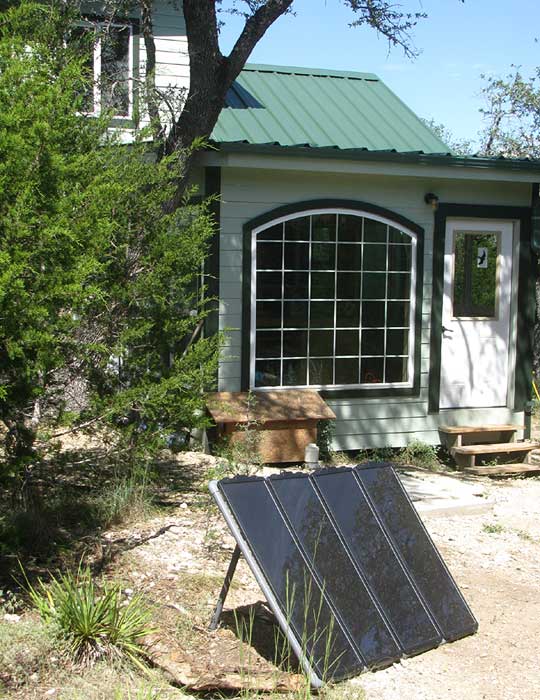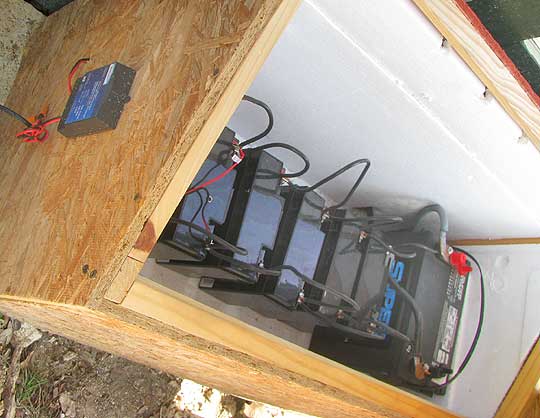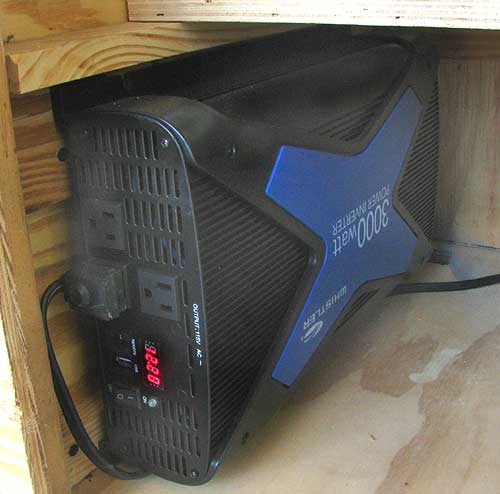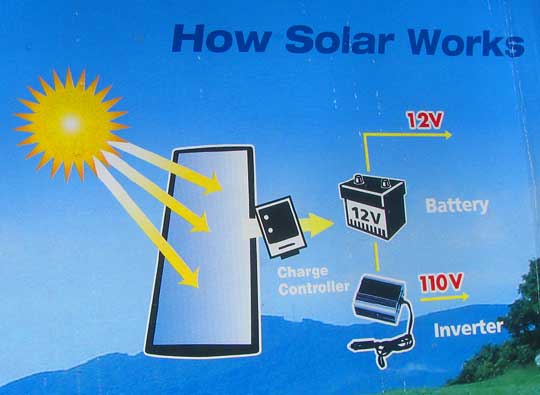Excerpts from Jim Conrad's
Naturalist Newsletter
from the September 15, 2013 Newsletter issued from the Frio Canyon Nature Education Center in the valley of the Dry Frio River in northern Uvalde County, southwestern Texas, on the southern border of the Edwards Plateau; elevation ~1750m (~5750 ft); N29.62°, W99.86°; USA
REFRIGERATOR RUNNING ON SUNLIGHT
Though for the last few months I've been cooking nearly all my meals on a solar cooker built from an abandoned satellite dish (as described at https://www.backyardnature.net/n/x/solar-ck.htm) this has been my first full week of having electricity available from solar cells. It's a small system bought by the property owner, my host, mainly to serve as an exhibition for others wanting to learn about solar energy. Also it helps us gain practical experience, since nothing is ever as simple as it looks on paper, and, of course, it's great having electricity from the sky.
Below, you can see the solar panels outside Juniper House's south-facing kitchen window:

The panels came as part of a kit marketed as a "Sunforce 60 Watt Solar 12 Volt Power Generator Kit," on Amazon.Com costing $253.08. Also in the kit were a charge controller, inverter, cables and connectors, all made in China.
When the sun is shining, each panel generates 15 watts of solar energy, so the four of them yield 60 watts. The panels produce direct current, DC, which goes to a bank of batteries. Something needs to keep the batteries from overcharging, and that's taken care of by a little black box called the charge controller, included in the kit. Below, you can see the controller mounted on the battery box's left side:

The charge controller has two lights. When the 12 volt batteries are a little overcharged, at 14.2 volts, the green light comes on and current from the panels is shunted away. When the batteries are at less than 14.2 volts, the light is yellow and the charger permits electricity from the panels to charge the batteries.
In the above picture the small batteries are Universal UB1210 12V, 18Ah (20HR), sealed, lead-acid, deep-cycle batteries, presently costing about $38.00 each, and they're bought separately. The 18Ah rating is "amp-hours," and 18Ah is regarded as pretty small. The larger battery in the back is a Super Start Captain costing about $85, but $15 less if you exchange an old battery. The large battery supplies as much storage capacity as all the smaller ones combined.
Electricity in the batteries can be used straight away if you just need 12 volt DC current -- something like a radio that otherwise runs on six C batteries. However, most house appliances utilize 110-volt alternating current. Therefore, an inverter is needed to convert 12 volt DC current to 110 volt AC current. A 200-watt inverter came with the kit, but a much larger inverter was bought. Below, you can see it mounted on the side of a cabinet wall in the kitchen:

That's a "Whistler 3000 Watt Power Inverter" costing $299.00 at Amazon.com. It's mounted where it can get good ventilation, since its alternating current is produced by large transistors that get hot. The digital window with red numbers keeps a running account of the voltage being supplied, reading 12.20 volts at this time. If the battery voltage drops to 10.5 volts an alarm goes off; if it reaches 10.0 volts, the system shuts down completely. It also shuts down if the voltage exceeds 15.5 volts. In the above picture the black cord plugged into the inverter goes to a half-size refrigerator.
The system works fine, the little refrigerator cooling nicely and the battery voltage staying at about 12 volts when the sun is shining. If clouds develop while the refrigerator runs, however, the voltage drops. At first we had only the small batteries, which couldn't carry the refrigerator through a whole night, and which closed down the inverter when a crockpot was plugged in. With the larger battery we can do these things, but on cloudy days the system might not make it through the night.
I'd hoped to run my laptop on the system, but now we know that our inverter produces a kind of AC current that might damage a laptop. Maybe you've seen the curvy sine-waves that depict AC current's alternating voltages. Our inverter produces "modified sine waves" that are square-cornered, not curvy, and not laptop friendly.
Another completely unforeseen situation is that the inverter's cooling fans sound like a small vacuum cleaner.
A much larger system would be needed to supply electricity for an average American household. However, I use much less electricity than most, and find that most of the time this system supplies all the electricity I need, except for the laptop.
If you want to review the circuitry, below, a picture of a section of the box in which the Sunforce Panel Kit came in schematically shows the system:
